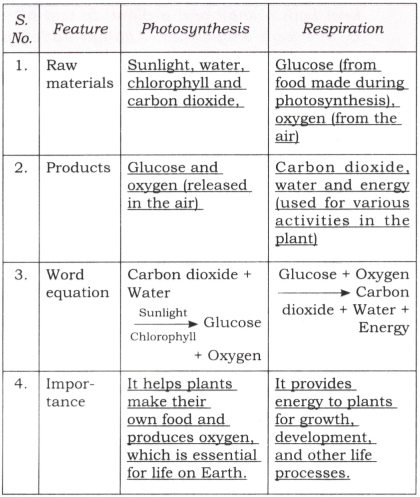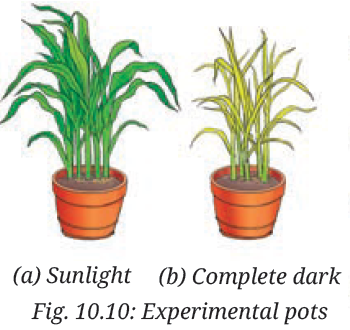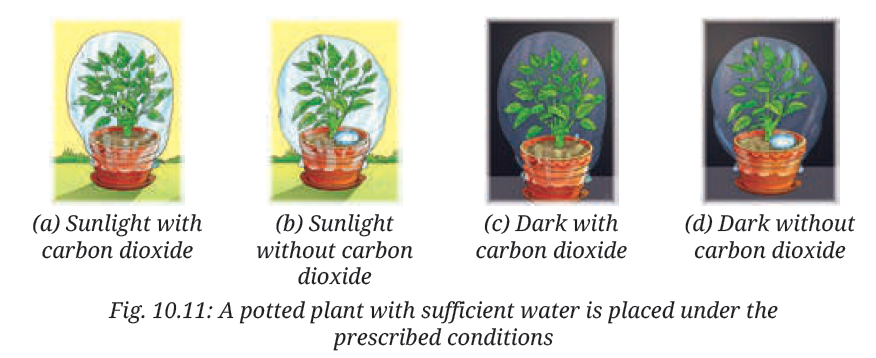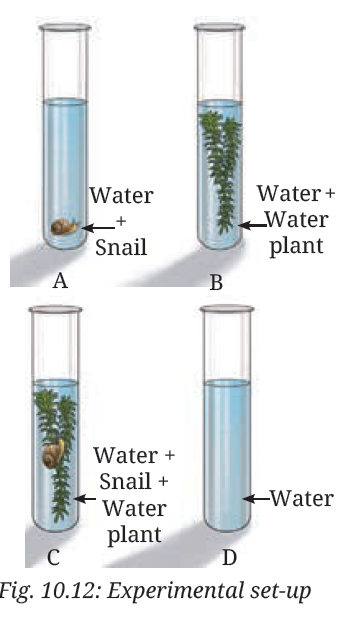Solutions For All Chapters – Science Curiosity Class 7
Life Processes in Plants
1. Complete the following table
Answer:
2. Imagine a situation where all the organisms that carry out photosynthesis on the earth have disappeared. What would be the impact of this on living organisms?
Answer: If all organisms that cany out photosynthesis disappeared, there would be no production of oxygen and food for other living organisms. This would disrupt the food chain, as plants provide food for herbivores and oxygen for respiration. Without plants, life on Earth would not be sustained.
3. A potato slice shows the presence of starch with iodine solution. Where does the starch in potatoes come from? Where is the food synthesised in the plant, and how does it reach the potato?
Answer: The starch in potatoes comes from the glucose produced in the leaves during photosynthesis. Photosynthesis occurs in the leaves, where food is synthesised in the form of glucose. This glucose is then transported through the plant to the potato, where it is stored in the form of starch.
4. Does the broad and flat structure of leaves make plants more efficient for photosynthesis? Justify your answer.
Answer: Yes, the broad and flat structure of leaves makes plants more efficient for photosynthesis. This shape increases the surface area, allowing more sunlight to be absorbed by the chlorophyll present in the leaves. It also helps in the exchange of gases through the stomata, thus enhancing the process of photosynthesis.
5. X is broken down using Y to release carbon dioxide, Z, and energy. X + Y → Carbon dioxide + Z + Energy. X, Y, and Z are three different components of the process. What do X, Y, and Z stand for?
Answer:
X stands for Glucose.
Y stands for Oxygen.
Z stands for Water.
This represents respiration, where glucose and oxygen produce carbon dioxide, water, and energy.
6. Krishna set-up an experiment with two potted plants of same size and placed one of them in sunlight and the other in a dark room, as shown in Fig. 10.10. Answer the following questions:
(i) What idea might she be testing through this experiment?
Answer : Krishna is testing the role of sunlight in photosynthesis and plant growth.
(ii) What are the visible differences in plants in both the conditions?
Answer : The plant in sunlight will grow better, with greener leaves and more height.
(iii) According to you, leaves of which plants confirm the iodine test for the presence of starch?
Answer : The leaves of the plant in sunlight will confirm the presence of starch (turn blue-black with iodine).
7. Vani believes that ‘carbon dioxide is essential for photosynthesis’. She puts an experimental set-up, as shown in Fig. 10.11, to collect evidence to support or reject her idea. Answer the following questions:
(i) In which plant(s) in the above set-up(s) will starch be formed?
Answer : Starch will be formed in plant (a) (sunlight with carbon dioxide), as it has all requirements for photosynthesis (sunlight, water, carbon dioxide, and chlorophyll).
(ii) In which plant(s) in the above set-up(s) will starch not be formed?
Answer :
Starch will not be formed in:
Plant (b) (sunlight without carbon dioxide), due to lack of carbon dioxide.
Plant (c) (dark with carbon dioxide), due to lack of sunlight.
Plant (d) (dark without carbon dioxide), due to lack of both sunlight and carbon dioxide.
(iii) In which plant(s) in the above set-up(s) will oxygen be generated?
Answer : Oxygen will be generated in plant (a) (sunlight with carbon dioxide), as photosynthesis occurs, producing oxygen.
(iv) In which plant(s) in the above set-up(s) will oxygen not be generated?
Answer :
Oxygen will not be generated in:
- Plant (b) (sunlight without carbon dioxide), as photosynthesis cannot occur without carbon dioxide.
- Plant (c) (dark with carbon dioxide), as photosynthesis requires sunlight.
- Plant (d) (dark without carbon dioxide), as photosynthesis does not occur.
8. Ananya took four test tubes and filled three-fourth of each test tube with water. She labelled them A, B, C, and D (Fig. 10.12). In test tube A, she kept a snail; in test tube B, she kept a water plant; in test tube C, she kept both a snail and a plant. In test tube D, she kept only water. Ananya added a carbon dioxide indicator to all the test tubes. She recorded the initial colour of water and observed if there are any colour changes in the test tubes after 2-3 hours. What do you think she wants to find out? How will she know if she is correct?
Answer :
What is she trying to find out?
- Ananya wants to find out how living organisms (snail and plant) affect carbon dioxide levels in water through respiration and photosynthesis.
How will she know if she is correct?
- In test tube A (snail only), the carbon dioxide indicator will show increased carbon dioxide (e.g., turn yellow if using a pH indicator like bromothymol blue), as the snail respires, releasing carbon dioxide.
- In test tube B (plant only), the indicator will show decreased carbon dioxide (e.g., stay blue or turn bluer), as the plant uses carbon dioxide for photosynthesis in sunlight.
- In test tube C (snail and plant), the indicator may show little change or stay balanced, as the plant uses the carbon dioxide produced by the snail, and the snail uses the oxygen produced by the plant.
- In test tube D (water only), the indicator will show no change, as there are no organisms to affect carbon dioxide levels.
- If these results match her observations, her hypothesis about the interaction of respiration and photosynthesis is correct.
9. Design an experiment to observe if water transportation in plants is quicker in warm or cold conditions.
Answer :
Materials needed: Two similar plant twigs (e.g., balsam), two glass tumblers, water, red food coloring, thermometer, warm water (around 30°C), cold water (around 5°C), magnifying glass.
Procedure:
- Fill two tumblers with water. Add a few drops of red food coloring to both.
- Label one tumbler “Warm” and heat its water to about 30°C. Label the other “Cold” and cool its water to about 5°C (use a thermometer to check).
- Cut the stems of two similar plant twigs obliquely under water to prevent air bubbles.
- Place one twig in the “Warm” tumbler and the other in the “Cold” tumbler.
- Keep both setups in the same room with similar light conditions.
- After 2-3 hours, observe the stems, leaves, and flowers for red color using a magnifying glass.
- Cut the stems and check how far the red color has traveled in the xylem.
Observation: If the red color travels farther in the “Warm” tumbler’s plant, water transportation is quicker in warm conditions. If farther in the “Cold” tumbler, it’s quicker in cold conditions.
Conclusion: Warm conditions likely speed up water transport due to increased molecular activity and lower water viscosity.
10. Photosynthesis and respiration are essential to maintain balance in nature. Discuss.
Answer : Photosynthesis and respiration are interconnected processes that maintain the balance of gases in nature.
Photosynthesis: Plants use carbon dioxide and water to produce glucose and release oxygen. This provides food for plants and oxygen for all living beings.
Respiration: Plants and animals use glucose and oxygen to produce energy, releasing carbon dioxide and water.
Balance: Photosynthesis removes carbon dioxide from the air and adds oxygen, while respiration uses oxygen and releases carbon dioxide. This cycle keeps the levels of these gases stable.
Without photosynthesis, carbon dioxide would increase, and oxygen would decrease, harming life. Without respiration, plants and animals wouldn’t get energy for growth.
Together, these processes support life by ensuring food, energy, and a balanced atmosphere.






bruh very long
this was very useful
thanks to Evidhyarthi
good but very short according to class 7